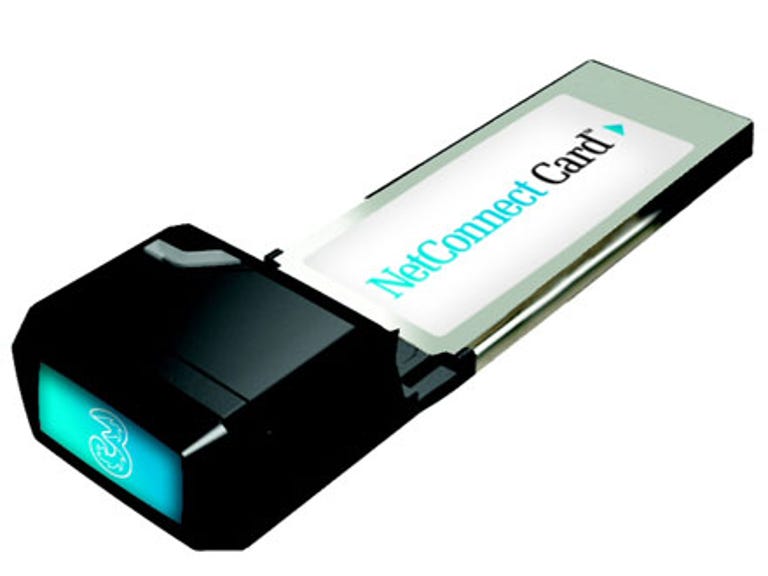 Why You Can Trust CNET
Why You Can Trust CNET 3 NetConnect Mobile Broadband Card (HSDPA) review: 3 NetConnect Mobile Broadband Card (HSDPA)
3's NetConnect mobile broadband card combines HSDPA speeds, compatibility with ExpessCard and PC Card laptop slots and exceptional pricing plans into a magic mobility mix.
Design
As the first wireless broadband ExpressCard on the Australian market, 3's new NetConnect card will place the carrier in pole position among large portions of the "road warrior" community.
The Good
The Bad
The Bottom Line
The reason? The past year has seen an increasing number of notebook manufacturers ditch the aging PC Card slot (also known as PCMCIA or CardBus) and embrace the high-speed architecture of the newer ExpressCard slot. This includes Apple's entire MacBook Pro line.
But until now, all mobile broadband solutions have been baked into a PC Card wafer or a USB modem. The former is incompatible with ExpressCard slots and the later is one more thing for the mobile maven to cart around, leave behind or lose altogether. USB dongles are also a messy look when hanging off a slick laptop.
The NetConnect card (a rebadged version of Novatel's Merlin XU870) adopts the slim footprint of the ExpressCard/34 format, so named for the card's 34mm width. The ExpressCard specification also includes the ExpressCard/54, which has the same 54mm width as the PC Card and the same 75mm length as the ExpressCard/34 (making it 1cm shorter than the PC Card) but with a "dog leg" shape.
Notebooks can have ExpressCard slots in either or both dimensions. Many Toshiba and HP laptops use the angled ExpressCard/54 (the remote control on selected HP laptops, for instance, is designed to dock into that slot), and these can also accept the straight ExpressCard/34 wafers.
3 has cannily included a PC Card adaptor cradle so that the ExpressCard wafer can be used in older notebooks with only a PC Card slot. At the same time, this provides users with a degree of future-proofing should they upgrade to a new ExpressCard-only notebook in the near future. A stout black hub at the end of the wireless card contains the transmitter and a slim flip-up aerial which, like most of its ilk, can get in the way if your hands hover around the farthest edge of the notebook's keyboard.
Features
As with the previous NetConnect PC Card (which has now been retired in favour of the ExpressCard package), the card can automatically roam onto Telstra's GSM/GPRS network when the 3G signal of its natural parent falls below a usable threshold or is absent altogether.
This brings with it vastly reduced speeds of around 60Kbps, making the experience similar to stepping down from ADSL to dial-up; you also get slugged with Telstra-imposed rates of AU$1.65/MB for using its network. To alleviate some of that sting in the contract's tail, 3's pricing plans include a small "buffer" allowance for GSM, although the amount (ranging from 2MB to 6MB according to your plan) is definitely on the lean side.
The Windows client software acts as a simple connection manager with support for "mobile" mode using the NetConnect card, as well as Wi-Fi and LAN -- the latter two modes work with the notebook's inbuilt wireless and Ethernet controllers. There's also an SMS client and SIM card address book manager, plus the ability to change the auto-roaming default so that the card remains locked onto the 3G network.
Mac notebooks don't need all this extra software -- the NetConnect card appears as just another item on the menu of ways to connect to the Internet once you install the drivers.
Performance
The NetConnect card makes the most of 3's network which holds large chunks of Sydney, Melbourne, Brisbane and the Gold Coast, Perth, Adelaide and Canberra under its wing.
Sydney and Brisbane have already been upgraded to HSDPA 3.6, with the remaining cities due for their speed boost before the end of March 2007.
Three warns customers that under its HSDPA network "data speeds will range from 600kbps to 1.5Mbps with theoretical maximum speeds of up to 3.6 Mbps", even though the Novatel card itself is currenlty rated for 3.6Mbps.
In the business centre of the Sydney Hilton -- smack in the middle of the city and surrounded by concrete and metal -- the NetConnect card latched onto a solid HSDPA signal and pulled in a consistent 1.4Mbps, redlining at 1.7Mbps.
Both indoors and outdoors at North Sydney the signal fluctuated from an average floor of 650kbps to a confident 1.2Mbps, although this can easily depend as much on the wavering population of users on the nearest base station as it does on the specific location.
These compare very well to tests in the same area prior to the HSDPA upgrade, which drew an average of 250Kbps with a peak of 325Kbps.
Although the NetConnect ExpressCard is more expensive than its counterparts from Telstra and Vodafone, the pricing plans represent exceptional value and can land you the card for anywhere from $20 down to zero if you sign a contract for 12 or 24 months.
And those plans themselves are sweet temptation. $29 per month gets you 200MB, $49 lifts the download ceiling to 1GB, while $69 lands you a hefty 2GB. Excess charges are a modest 10c/MB. These deals are substantially cheaper than the equivalent mobile broadband offerings of Telstra's BigPond Next G and Vodafone's HSDPA 3G.
Editor's note: The performance section of our 3 NetConnect HSDPA ExpressCard review has been revised from the original (20 November, 2006) to reflect 3's network upgrade to HSDPA 3.6Mbps.

